WingNut Wings 1/32 Pflalz D.IIIa
|
KIT #: |
32006 |
|
PRICE: |
$65.00 SRP postage included
|
|
DECALS: |
Five options |
|
REVIEWER: |
Tom Cleaver |
|
NOTES: |
Lozenge decals included |

Pfalz Flugzeug‑Werke GmbH of Bavaria obtained a license to produce
Morane aircraft in 1914, shortly before the commencement of the First World War.
Following the success of the Fokker Eindekker in 1915, the company
modified the Morane “parasol” design to one similar in layout to the Fokker
airplane. The Pfalz Eindekker
was heavier than the Fokker, and didn't perform as well ‑ this would be the
story of Pfalz fighters throughout the war: the best second choice. As a
Bavarian company, Pfalz' Eindekker equipped units of the semi-independent
Bavarian Air Force.
Pfalz
obtained a subcontract to build the Roland D.II, which gave them experience in
the singular Roland method of building a monocoque wood fuselage, using wrapped
wood strips to make a light yet strong structure.
Building on this experience, Pfalz set out to design a fighter superior
to the failed Roland design, that could compete with the Albatros D.III
series. Fortunately for Roland, the
one thing they did absolutely right in this decision was to keep a standard
double spar in the smaller lower wing; no Pfalz fighter ever suffered the
structural failures that plagued Albatros once they went over to the single‑spar
lower wing
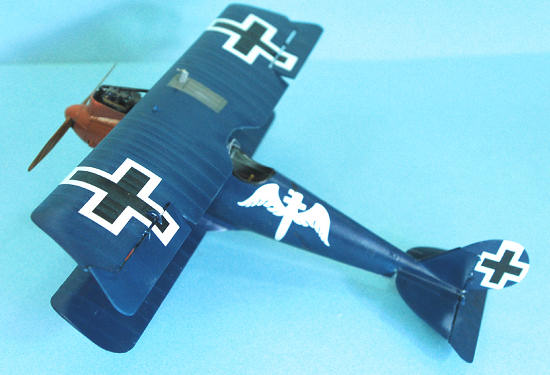 sesquiplane
design.
sesquiplane
design.
Designed
in late 1916 and flown in the spring of 1917, the Pfalz D.III
was powered by the same 160 h.p. Mercedes the Albatros used, giving it a speed
of 103 mph, which was slower than the Albatros and attributable to the extra
weight of the Pfalz design. While
the airplane was more directly comparable to the Albatros D.III,
it entered service in August 1917 at around the same time as the Albatros D.V
and D.Va.
The Pfalz
D.III
was criticized for having heavy controls, lack of speed, and lack of power ‑ or
lack of climb when compared to the Albatros (it took 17 minutes to reach 16,000
feet). The D.III
was found to stall sharply and spin readily, going into a flat spin if not
recovered quickly. The D.III
also slipped in turns and lost altitude readily, which led to crashes when
unwary pilots turned at very low altitudes.
The Pfalz
D.III
served primarily with units of the Bavarian Air Force, though many pilots in the
Luftkreitskraft (German Air Service) preferred the Pfalz to any of the
Albatros fighters, primarily due to the fact that while it might not have been
as maneuverable, it could be thrown around the sky without fear of losing a
wing. Being heavier than the
Albatros fighters and also unlikely to come apart when pulling out of a
prolonged dive, the Pfalz D.III
was a favorite for attacking observation balloons along the front.
The one
major problem found with the D.III
was that its twin Spandau machine guns were mounted inside the fuselage, which
made it difficult to clear a jam in combat, since the pilot would have to lean
over and look inside the cockpit to reach the weapons. Entering service in the
fall of 1917, the D.IIIa solved this problem by mounting the guns atop the
fuselage ahead of the cockpit.
The Pfalz
and the Albatros fighters were quickly overshadowed by the introduction of the
Sopwith Camel, the S.E.5a, and the SPA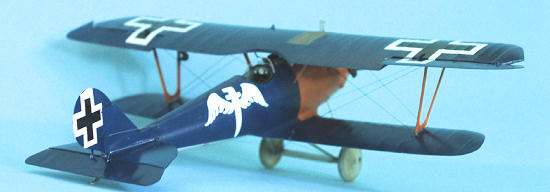 D
fighters. By late 1917, the German
air service was being regularly out‑flown by the more numerous Allied fighters,
which led to the priority design of the Fokker D.VII
and the re‑equipment of the German Jastas in the spring and summer of 1918.
D
fighters. By late 1917, the German
air service was being regularly out‑flown by the more numerous Allied fighters,
which led to the priority design of the Fokker D.VII
and the re‑equipment of the German Jastas in the spring and summer of 1918.
Pfalz
produced 260 D.III
and 750 D.IIIa aircraft by April 1918 when production ceased in preparation for
the Pfalz. D.XII. 430 D.IIIa scouts
were in service in June 1918; by August, the number had dropped to 166, with
most withdrawn from frontline units and assigned as trainers.
Rudolf Berthold:
The son of a forester, Rudolf Berthold was born
March 24, 1891,
in
Brandenberg,
Prussia.
Joining the Army as an infantryman with the 3rd Brandenberg Infantry
regiment in 1910, Berthold took flight training at his own expense in 1913, and
qualified as a pilot in September 1913. He transferred to the Luftkreitskraft
in August 1914, and flew as an
Observer with
FFA
23 for the first year of the war, during which time he won the Iron Cross 1st
and 2nd Class. Falling heir to a
Fokker Eindekker in November 1915 when his good friend Hans‑Joachim
Buddecke was transferred to
Turkey,
Berthold began his career as a fighter pilot.
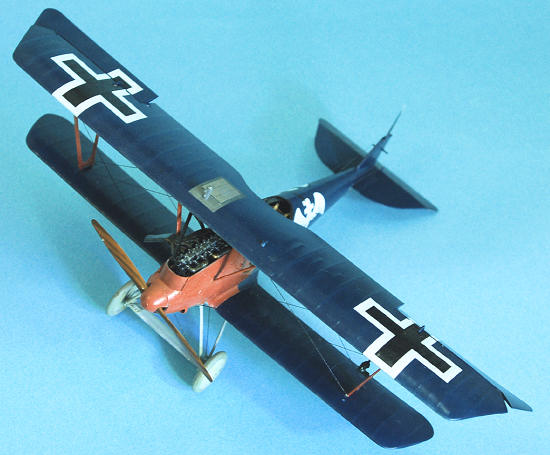 Having scored five victories by April 1916, Berthold suffered a broken
pelvis when he crashed a Pfalz E.IV on April 26.
Returning to combat that summer, he scored his sixth victory on August
24. The next day the unit, Kek
Vaux, became Jagdstaffel 4, with Berthold named the commander.
He was transferred to Jasta 14 as C.O. in October, 1916, following
Buddecke's return from
Turkey,
where he remained until he was again badly injured in combat, suffering a
fractured skull, broken nose, pelvis and thigh.
In August, 1917, he took command of Jasta 18, which adopted the
distinctive red-blue colors of the 3rd Brandenberg regiment with which Berthold
had served. On
October 10, 1917,
a bullet crippled his right arm. He
was also awarded the Pour le Mérite that day and two weeks later was
promoted to Hauptmann. His
behavior that fall was erratic due to the morphine he was taking for his arm,
and he took extended leave to break the addiction.
In March 1918, he again returned to combat and was given command of
Jagdgeschwader II. He managed
to transfer his entire group of pilots from Jasta 18 to Jasta 15
to serve with him in the new command.
He flew the Pfalz D.IIIa in preference to the Albatros D.V that was now
the primary equipment of his unit, due to the Pfalz having the throttle on the
stick, which allowed him to fly one-handed.
In May 1918 the unit re-equipped with the Fokker D.VII.
By the end of the war, his score stood at 44 victories.
Having scored five victories by April 1916, Berthold suffered a broken
pelvis when he crashed a Pfalz E.IV on April 26.
Returning to combat that summer, he scored his sixth victory on August
24. The next day the unit, Kek
Vaux, became Jagdstaffel 4, with Berthold named the commander.
He was transferred to Jasta 14 as C.O. in October, 1916, following
Buddecke's return from
Turkey,
where he remained until he was again badly injured in combat, suffering a
fractured skull, broken nose, pelvis and thigh.
In August, 1917, he took command of Jasta 18, which adopted the
distinctive red-blue colors of the 3rd Brandenberg regiment with which Berthold
had served. On
October 10, 1917,
a bullet crippled his right arm. He
was also awarded the Pour le Mérite that day and two weeks later was
promoted to Hauptmann. His
behavior that fall was erratic due to the morphine he was taking for his arm,
and he took extended leave to break the addiction.
In March 1918, he again returned to combat and was given command of
Jagdgeschwader II. He managed
to transfer his entire group of pilots from Jasta 18 to Jasta 15
to serve with him in the new command.
He flew the Pfalz D.IIIa in preference to the Albatros D.V that was now
the primary equipment of his unit, due to the Pfalz having the throttle on the
stick, which allowed him to fly one-handed.
In May 1918 the unit re-equipped with the Fokker D.VII.
By the end of the war, his score stood at 44 victories.
Following the German surrender in November 1918, Berthold formed the "Fränkische
Bauern‑Detachment Eiserne Schar Berthold" of the Freikorps in April
1919, and took part in fighting against the Communists.
After taking part in the failed Kapp Putsch to overthrow the
Weimar
government and install a military dictatorship, Berthold was shot and killed on
March 15, 1920
in Harburg during a riot between communist and nationalist factions.
The mythology that grew around him in later years had him strangled by
the ribbon of his “Blue Max” after being wounded in this fight, but this has
been proven false in later research.
The Pfalz D.III
series has been popular ever since
Aurora
released the first 1/48 injection-molded kit of this airplane 50-plus years ago.
That kit was re-released in the 1990s by Glencoe and can still be found;
while an acceptable model can be made with
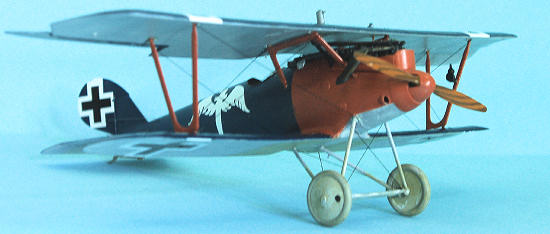 this kit,
it does not measure up to the later Eduard 1/48 releases, which are among the
best kits this great company ever did.
The
Aurora
kit and one of the Eduard kits are of the D.IIIa, while Eduard also released an
earlier D.III.
In 2008, Roden released a 1/32 D.III
(which is also reviewed here at Modeling Madness).
This kit by Wingnut Wings is the first 1/32 kit of the better-known
D.IIIa.
this kit,
it does not measure up to the later Eduard 1/48 releases, which are among the
best kits this great company ever did.
The
Aurora
kit and one of the Eduard kits are of the D.IIIa, while Eduard also released an
earlier D.III.
In 2008, Roden released a 1/32 D.III
(which is also reviewed here at Modeling Madness).
This kit by Wingnut Wings is the first 1/32 kit of the better-known
D.IIIa.
The 147 injection-molded parts include two different lower wings, to
cater for the early and late-production D.IIIa.
Surface detail for the wings and control surfaces is highly realistic,
with in-scale rib tape on the upper and lower wings, something no other kit
manufacturer has accomplished.
Cartograf decals cover five different early and late production D.IIIa
airplanes, with a separate sheet of 4-color lozenge to use for those options
with camouflaged wings.
Wingnut Wings also released two “aftermarket” decal sheets (both reviewed
here at Modeling Madness), “Flying Circus,” Part 1 and Part 2.
Part 2 includes five different airplanes, three of which were flown by
famous aces, one of whom was Rudolf Berthold.
It was these markings I chose to use for this model.
Construction of any Wingnut Wings kit is really simple, due to the fact
that the parts are made to fit, and the instruction
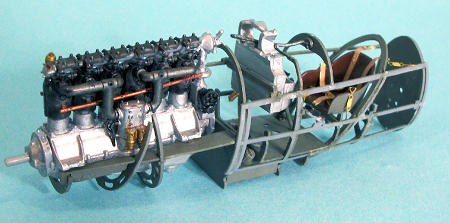 sheet is
complete and logical.
sheet is
complete and logical.
As usual with these kits, I chose to pre-paint as many of the detail
parts as possible before taking the parts off the sprues.
I did have a question about the color call-out for the interior being
“grey-green,” or RLM02, but confirmed that with my friend, well-known World War
I researcher and artist Robert Karr.
I used Xtracrylix RLM02 Grau for this.
With everything pre-painted, I proceeded to continue committing the
radical act of following the instructions, and had a problem-free assembly
process, completed over the course of an afternoon.
Once the interior was assembled, it was set into the left fuselage half
and glued in position. Be certain
to get the parts fitted right; be sure to shave off all the excess when you cut
them from the sprues, because everything fits very precisely.
If you
 do that,
things “click” into position.
do that,
things “click” into position.
Once I had the fuselage halves glued together, I attached the lower wing.
Because I had taken the time to be sure the interior was correctly placed
inside the fuselage and the fuselage correctly assembled, the very tight-fitting
lower wing went into position without problem.
Once this was done, I applied Tamiya Grey Surfacer to the fuselage
centerline and the fore and aft joint of the lower wing.
This was then sanded smooth and the seams disappeared.
I finished off by attaching the horizontal stabilizer.
The lower surfaces were painted “Silbergrau,” which I created by
mixing Tamiya “Flat Aluminum” with “Flat White” to get a greyed-out silver
color. The forward fuselage and the
cabane and interplane struts were painted “German Red” using a mixture of Tamiya
“Flat Red” and “Sky Grey” to get the “greyed-out” red color.
The “Prussian Blue” was mixed using Tamiya “Field Blue” and Tamiya
“Blue”. When this was dry, the
model was given a coat of Xtracrylix Gloss Varnish.
The decals went on without difficulty under a coat of Micro-Sol.
I washed the model to get rid of setting residue and gave it a final coat
of Xtracrylix Satin Varnish.
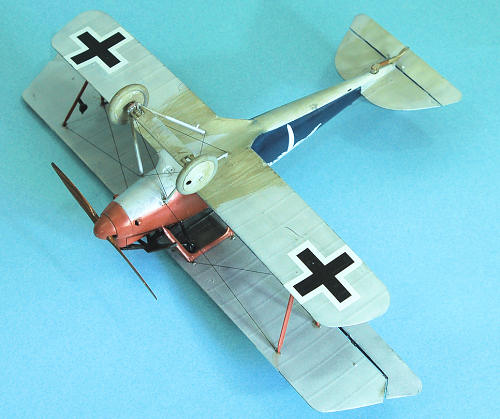 Given that the Spring of 1918 when this airplane saw action was the
rainiest in 50 years, I “muddied” the wheels and lower wing surface with the
Tamiya weathering set. I then
attached the control surfaces in “dynamic” positions that were in accordance
with how I had set the controls when assembling the cockpit.
The cabane and interplane struts have long connecting pins that are
molded at the correct angles, so there is no difficulty in aligning them and the
upper wing. The same is true with
the landing gear legs and the tail skid.
Given that the Spring of 1918 when this airplane saw action was the
rainiest in 50 years, I “muddied” the wheels and lower wing surface with the
Tamiya weathering set. I then
attached the control surfaces in “dynamic” positions that were in accordance
with how I had set the controls when assembling the cockpit.
The cabane and interplane struts have long connecting pins that are
molded at the correct angles, so there is no difficulty in aligning them and the
upper wing. The same is true with
the landing gear legs and the tail skid.
The model was rigged with .008 wire, painted black to make it more
noticeable.
Another winner from Wingnut Wings.
The Pfalz D.IIIa, with its relatively simple rigging, is a good kit for a
modeler just entering the World War I genre, to gain experience with rigging a
biplane. The kit is complex but not
complicated, and any modeler of average skill will have no difficulty creating a
masterpiece following the instructions.
Anyone who can't find inspiration among the 15 markings possibilities,
which cover just about every well-known Pfalz D.IIIa for which there is good
photo documentation, would have to be trying not to. I think the Pfalz D.IIIa is
one of the nicest-looking First World War fighters, and with all these markings,
there is a distinct possibility that more than one of these excellent models
will find its way to my shelves.
Highly recommended to anyone with interest in First World War aviation - build
in confidence.
Tom Cleaver
May 2011
Review kit and
decals courtesy of Wingnut Wings.
Order yours at www.wingnutwings.com
If you would like your product reviewed fairly and quickly, please
contact
me or see other details in the
Note to
Contributors.
Back to the Main Page
Back to the Review
Index Page


 sesquiplane
design.
sesquiplane
design. D
fighters. By late 1917, the German
air service was being regularly out‑flown by the more numerous Allied fighters,
which led to the priority design of the Fokker D.
D
fighters. By late 1917, the German
air service was being regularly out‑flown by the more numerous Allied fighters,
which led to the priority design of the Fokker D. Having scored five victories by April 1916, Berthold suffered a broken
pelvis when he crashed a Pfalz E.IV on April 26.
Returning to combat that summer, he scored his sixth victory on August
24. The next day the unit, Kek
Vaux, became Jagdstaffel 4, with Berthold named the commander.
He was transferred to Jasta 14 as C.O. in October, 1916, following
Buddecke's return from
Having scored five victories by April 1916, Berthold suffered a broken
pelvis when he crashed a Pfalz E.IV on April 26.
Returning to combat that summer, he scored his sixth victory on August
24. The next day the unit, Kek
Vaux, became Jagdstaffel 4, with Berthold named the commander.
He was transferred to Jasta 14 as C.O. in October, 1916, following
Buddecke's return from  this kit,
it does not measure up to the later Eduard 1/48 releases, which are among the
best kits this great company ever did.
The
this kit,
it does not measure up to the later Eduard 1/48 releases, which are among the
best kits this great company ever did.
The  sheet is
complete and logical.
sheet is
complete and logical.  do that,
things “click” into position.
do that,
things “click” into position. 